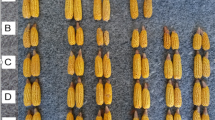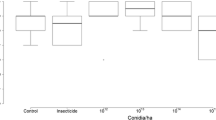Abstract
In 1974, an application of the microsporidan,Nosema pyrausta (Paillot, 1927)Kotlan, 1928, with a back-pack type sprayer (22.5×107 spores/plant) to whorl stage maize infested with European corn borers,Ostrinia nubilalis (Hübner) reduced the number of larvae/plant by 48.1% and produced an infection of 15.3×104 spores/mg of larval weight in 62.1% of the collected larvae. In 1975, applications of 24.3×107 spores/plant to similar maize, in 2 separate tests, reduced the number of larvae/plant by 18.8 and 43.8% and caused an infection of 14.3 and 19.1×104 spores/mg of larval weight in 65.9 and 63.3% of the collected larvae. Also, in 1975, applications of 24.3×107 spores/plant to pollen shedding maize in 2 separate tests reduced the number of larvae/plant by 17.2 and 14.1% and caused an infection of 24.3 and 27.2×104 spores/mg of larval weight in 99.2 and 95.2% of the collected larvae.
Résumé
La microsporidie,Nosema pyrausta (Paillot, 1927;Kotlan, 1928) a été appliquée avec un pulvérisateur à dos, sur du maïs à la phase du verticille et sur du maïs émettant le pollen, attaqués par la pyrale du maïs sansNosema. Ces 2 stades de croissance du maïs correspondent à la 1re et à la 2e génération de la pyrale du maïs,Ostrinia nubilalis dans l'Iowa.
Une suspension aqueuse de spores deN. pyrausta a été appliquée sur le verticille de la plante pour des essais sur la 1re génération et aux 3 nœuds au-dessus et au-dessous de l'épi pour les essais sur la 2e génération. En 1974 (1re génération),N. pyrausta a abaissé le nombre de larves par plante de 48,1% et a causé une infection de 15,3×104 spores/mg de larve chez 62,1% des insectes récoltés. En 1975 (1re génération),N. pyrausta a abaissé le nombre de larves par plante de 18,8% et 43,8% dans 2 essais et a causé une infection de 24,3 et 27,2×104 spores/mg de larve chez 65,9% et 63,3% des larves récoltées. En 1975 (2e génération),N. pyrausta a abaissé le nombre de larves par plante de 17,2% et 14,1% dans 2 essais et a causé une infection de 24,3 et 27,2×104 spores/mg de larve chez 99,2% et 95,2% des insectes collectés. L'impact de cette application sur les populations de pyrale ultérieures est discuté.
Similar content being viewed by others
References
Harris, H. M. &Brindley, J. M. — 1942. The European corn borer in Iowa. —J. Econ. Entomol. 35, 940–941.
Henry, J. E. — 1971. Experimental application ofNosema locustae for control of grasshoppers. —J. Invertebr. Pathol., 18, 389–394.
Kaya, H. K. — 1975. Persistence of spores ofPleistophora schubergi [Cnidospora: Microsporida] in the field, and their application in microbial control. —J. Invertebr. Pathol., 26, 329–332.
Kramer, J. P. — 1959. Some relationships betweenPerezia pyraustae Paillot [Sporozoa, Nosematidae] andPyrausta nubilalis (Hübner) [Lepidoptera, Pyralidae]. —J. Insect Pathol., 1, 25–33.
Lewis, L. C. &Lynch, R. E. — 1974. Lyophilization, vacuum drying and subsequent storage ofNosema pyrausta spores. —J. Invertebr. Pathol., 24, 149–153.
Lewis, L. C. &Lynch, R. E. — 1976. Influence on the European corn borer ofNosema pyrausta and resistance in maize to leaf feeding. —Environ. Entomol., 5, 139–142.
Lewis, L. C., Lynch, R. E. &Guthrie, W. D. — 1971. Biology of European corn borers reared continuously on a diet containing Fumidil B. —Ann. Entomol. Soc. Am., 64, 1264–1269.
Lynch, R. E. &Lewis, L. C. — 1976. Influence on the European corn borer ofNosema pyrausta and resistance in maize to sheathcollar feeding. —Environ. Entomol., 5, 143–146.
Raun, E. S., York, G. T. &Brooks, D. L. — 1960. Determination ofPerezia pyrausta infection rates in larvae of the European corn borer. —J. Insect Pathol., 2, 254–258.
Showers, W. B. &Reed, G. L. — 1971. Three generations of European corn borer in central Iowa. —Proc. North Cent. Branch. E.S.A. Entomol. Soc. Am., 26, 53–56.
Van Denburgh, R. S. &Burbutis, P. O. — 1962. The host-parasite relationship of the European corn borer,Ostrinia nubilalis, and the protozoan,Perezia pyraustae, in Delaware. —J. Econ. Entomol., 62, 65–67.
Windels, M. B., Chiang, H. C. &Furgala, B. — 1976. Effects ofNosema pyrausta on pura and adult stages of the European corn borerOstrinia nubilalis. —J. Invertebr. Pathol., 27, 239–242.
Zimmack, H. L. &Brindley, T. A. — 1957. The effect of the protozoan parasitePerezia pyraustae Paillot on the European corn borer. —J. Econ. Entomol., 50, 637–640.
Zimmack, H. L., Arbuthnot, K. D. &Brindley, T. A. — 1954. Distribution of the European corn borer parasitePerezia pyraustae and its effect on the host. —J. Econ. Entomol., 47, 641–645.
Author information
Authors and Affiliations
Additional information
Journal Paper No. 8735 of the Iowa Agriculture and Home Economics Experiment Station, Ames, Iowa. Project No. 2183.
Mention of a proprietary product in this paper does not constitute an endorsement of this product by the U.S.D.A. or its cooperators.
Rights and permissions
About this article
Cite this article
Lewis, L.C., Lynch, R.E. Foliar application ofNosema pyrausta for suppression of populations of European corn borer. Entomophaga 23, 83–88 (1978). https://doi.org/10.1007/BF02371995
Issue Date:
DOI: https://doi.org/10.1007/BF02371995




